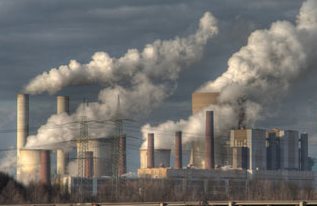Particle pollution, also called particulate matter, is small bits of soot, dust, metals, chemicals, or droplets that float (stay suspended) in the air. Particle pollution is not a gas, but very small particles. Smoke is a stream of particle pollution so thick we can see it. When it spreads out, we don’t see it any longer, but the particles are still there. Particle pollution is classified by size: coarse (10 microns or less), fine (2.5 microns or less).
What’s In Particle Pollution?
Particle pollution mostly comes from burning fuel – for power, for factories, for trucks and cars, or from trees burning during a wildfire. It can also come from dust kicked into the air by trucks and traffic. It can contain carbon (soot), or very small droplets that are made from chemical reactions of chemicals that come from burning: sulfur dioxide and nitrogen oxides. Particle pollution can also contain chemicals from the coal, gas, or wood that was burned (polycyclic aromatic hydrocarbons), and it can also contain heavy metals such as arsenic or mercury that were in the coal or gas.
Why is Particle Pollution so Dangerous to Our Health?
When we breathe in particle pollution, some of it damages our airways, and some of it damages our lungs, and some of it goes deep into the smallest air sacs in our lungs. Some of it is small enough to go straight from our lungs into our blood. When we breathe it, whatever is part of the particle goes into our airways and lungs – chemicals, soot, heavy metals, and more. Because some of it gets into our blood, it can cause or worsen many diseases, not just lung diseases.
For more information about particle pollution, visit the EPA website, or the American Lung Association website.





